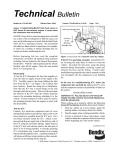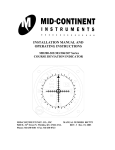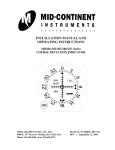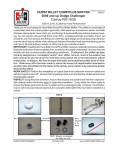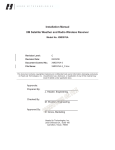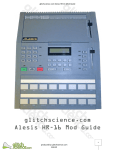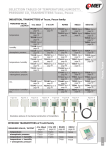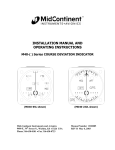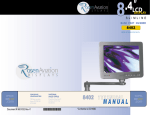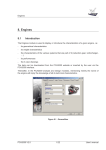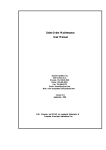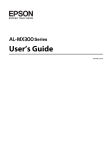Download MX300 NAV - COMM OWNER`S MANUAL
Transcript
MX300 NAV - COMM OWNER'S MANUAL TKM, INC 14811 NORTH 73rd STREET SCOTTSDALE, AZ 85260 PART # MNO300, REV. 3 NOV 16,1998 2 EQUIPMENT DESCRIPTION The unit features digital (LED) displays for active (yellow) frequency channel and standby (red) frequency channel for both COMM and NAV. For channel selection a MHz knob and a KHz knob are provided. For 25 KHz increments in COMM, a 25 KHz button is provided. To activate COMM or NAV frequency selection, an N/C button is provided; a "tic" appears in the selected standby channel display. Channel selection operates on the standby channel only. When the desired channel is indicated in the standby display it may be placed into the active position by depressing the "Flip-flop" button located to the left of the displays (labeled COMM and NAV) the active channel is then placed into the standby position. The NAV receiver features a AC/ID button to permit selection of voice or ident reception. In the Ident condition a "tic" is displayed on the active NAV channel display. The COMM transceiver features a test button which overrides the squelch to verify proper receiver operation and to allow reception of weak signals. Also provided on the active COMM display, is a "tic" to indicate transmitter power output. A VOR test button is provided on the front panel to inject a 0 degree FROM bearing into the Navigation converter circuits when a solid VOR signal is being received; a bearing adjustment can then be made through the adjustment hole by the KHz switch. The adjustment hole by the MHz switch permits operator adjustment of the display dimmer range for optimum nighttime brightness. * The "tic" is the upper half of “1” and is found to the left of the 100's digit. 3 SPECIFICATIONS Mounting: Panel mounted, no shock mounting required. Size: 6.312 x 3.120 x 12.15 inches w/connectors Weight: 6.0 lbs excluding external connector and harness. Power Requirements: 13.75 Vdc (or 27.5 v w/CONV) NAV and COMM Recv'r Max COMM Total w/ Transmit (Tone) 1.8A 7.1A (6. 2A unmodulated) COMM Transceiver Crystal Controlled: 760 Channel Frequency Range: 118.00 to 136.975 MHz Frequency Stability: +/- .003%. -20 to 50C Transmitter VHF Power Output: 8 watts minimum, 50 ohm Modulation: 85% capability with 90% limiting Microphone: Dynamic mike containing transistorized preamp or carbon (must provide at least 120 mV rms into 500 ohm load). Sidetone: Adjustable up to 40 mw into 500 ohm headphones. Duty Cycle: 1 minute on, 4 minutes off (20%). Receiver Sensitivity: 1.5 uv (soft) will provide a 6 db minimum signal plus noise ratio (KHz, 30% mod). Selectivity: Typical 6 db at + 7.5 KHz, 65 db at + 17.5 KHz, 90 db at + 25 KHz. Spurious Responses: Down at least 70 db. 4 Squelch: Noise adaptive squelch with manual override. AGC Characteristics: From 2 to 100.000 uV audio output will not vary more than 1 db. NAV Receiver Crystal Controlled: 200 Channels Frequency Range: 108.00 to 117.95 MHz Sensitivity: 1.5 uv (soft) will provide a half-flag indication. Selectivity: Typical 6 db at + 15 KHz, 60 db at + 35 KHz, 80 db at + 50 KHz Spurious Responses: Down at least 70 db Ident Filter: 15 db minimum AGC Characteristics: From 2 to 100.000 uV audio output will not vary more than 1 db NAV Receiver Accuracy: Two sigma limit, + 1 degree NAV Output: With LOC adjusted for 0.35 Vrms VOR = 0.5 Vrms (typical) into 20k ohms or greater load impedance DME Channeling: 2x5 G / S Channeling: 2x5 AUDIO Auxiliary Audio Inputs: Five (5) 500 ohms with 30 db isolation between any two. Frequency Response: Within 6 db from 350 Hz to 2500 Hz Headphone Output: 50 mw into 500 ohm Speaker Output: 4.5 Vrms into auxiliary input produces 5 watts audio output. 5 EQUIPMENT LIMITATIONS The following limitations indicate where the MX300 may be installed and meet the applicable TSO requirements: 1. Equipment is intended for installation within a nonpressurized But controlled temperature location in an aircraft that is operated at altitudes up to 35000 feet MSL. 2. Equipment is intended for use in a Standard Humidity Environment. 3. Equipment is intended to be panel mounted in Single and Multi Engine Fixed Wing Aircraft with Reciprocating and Turbopropeller Engines. 4. Equipment shall not be mounted less than 0.3 m from magnetic compass. 5. Unit has not been tested with autopilots. ASSOCIATED EQUIPMENT The MX300 is designed to be used as a direct replacement for the Cessna/ARC RT328T. The unit is dimensionally identical to the ARC units and can therefore use existing aircraft installations. Except for improved performance characteristics, the unit is electrically interchangeable with the ARC unit and will provide the proper audio, navigation signal and channeling signals for existing installations. New installations can be made using RT 328T installation kits which are available as an optional accessory. Additionally the MX300 will directly replace the following NAV/COMM'S: RT308C RT328C RT508A RT528E RT328A RT328D RT528A The RT308C, RT328A, and RT528A use pin L of J3 instead of pin BB of J4 to output the NAV demod signal. The MX300 may be ordered with the different output pin or may be modified in the field. An optional adapter is available which permits the replacement of the following NAV/COMM'S: RT517 RT514R RT540 RT515R RT515A-1 The MX300 will interface directly with the ARC IN525A Course Deviation Indicator and similar units. 6 The remote channeling outputs of the unit permit channeling of Glide Slope receivers and DME using the ARINC 2 out of 5 channeling system. INSTALLATION The MX300 is designed to be an exact replacement for the ARC RT328T and similar units. As a replacement unit, the MX300 is inserted directly into the mounting tray for the RT328T and tightened down with a small ( .125 dia. max. ) Phillips head screwdriver. For new installations the Installation instructions for the RT328T should be used. To remove the MX300 from the mounting tray it is important to note that the Channel Selector knobs should not be used. The first step in removal is to ensure that the mounting clamp has been fully disengaged by rotating the clamp screw counterclockwise with the tool described above; it should be noted that the clamp screw is a holding device and not an extraction device. The unit may then be pryed from the tray with a thin flat bladed screwdriver when access to the front corners has been made available. OPERATING INSTRUCTIONS Operating controls for the MX300 are located on the unit front panel or are remote inputs thru the rear panel. The unit front panel is shown in figure 1. The left hand COMM readout indicates the active COMM frequency and the right hand COMM readout indicates the standby COMM frequency. The left hand NAV readout indicates the active NAV frequency and the right hand NAV readout indicates the standby NAV frequency. A "tic" readout is provided on the upper left hand corner of the first digit of each of the four frequency readouts. The active COMM "Tic" indicates the presence of transmitter power. The standby COMM "Tic" indicates that the Frequency Selection knobs will control COMM standby frequency . The active NAV "Tic" indicates that the NAV receiver is in the Ident Mode. The standby NAV "Tic" indicates that the Frequency Selector knobs will control NAV standby frequency. Power Application. The COMM volume control contains the master power switch and activates both the NAV and COMM functions. Frequency Selection. The N/C button is used to activate either the COMM or the NAV frequency 7 selection as indicated by the appropriate "Tic" display. The MHz and KHz controls can then be used to select a desired standby channel. In COMM the 112511 button is used to advance the frequency by 25 KHz. After the desired standby frequency is selected it may be transferred to the activate position by pressing the flip-flop button to the left of the ACTIVE display. The active and standby channels will be interchanged each time the button is pressed. Ident/Voice Selection. The ID/VC button can be used to select a tone filter in order to receive voice signals on the NAV receiver. The switch is also used for frequency storage as described below. Test. The TEST button is a dual function switch. In normal operation, it is used to override the squelch to verify receiver operation and to receive weak signals. The switch is also used for frequency storage as described below. Frequency Storage. Up to 100 frequencies may be stored in the unit's memory. A COMM frequency selected in the standby display may be transferred to memory by pressing and holding TEST while pressing the flip-flop button. When a frequency is inserted into memory the next available frequency is taken from memory and placed into standby. If no frequencies are in memory the standby will indicate 10000. A NAV frequency selected in the standby display may be transferred to memory by pressing and holding VC/ID while pressing the NAV flip-flop button. When 10000 is present in the standby display, a new channel can be selected and placed into memory in the manner previously described. In the group of frequencies stored in memory, there will always be one and only one 10000. At the upper or lower end of the NAV or COMM frequency ranges, a 10000 display will be available. To delete a channel from memory, it must be sequenced to the standby display and set to 10000 by the frequency selector switches; transferring of the 10000 to storage will then eliminate the undesired frequency. Transmit. The transmit mode on the transceiver is selected by pressing the transmit button on the microphone. Channel Reset. If it is desired to clear memory, a system reset may be accomplished by turning off the main power switch, pressing and holding TEST button and then turning on the main power switch; after reset the COMM. Active will read 121.5 and the COMM standby will read 120.0. The Nav Active will read 108.0, NAV standby 112.0. VOR OBS Adjustment. OBS test can be made by tuning in a solid VOR station and depressing the VOR button. The L-R needle should be centered with a bearing of 0 degrees FROM or 180 degrees TO. if an error exists the VOR bearing may be adjusted through the hole 8 in the front panel by the KHz switch marked V. Display Dimmer Adjustment. The dark end of the automatic display dimmer range is adjustable through the front panel hole by the MHz switch marked D. ENVIRONMENTAL QUALIFICATION FORM Model MX300 NAV/COMM as specmanufactured by TKM, INC., 14811 North 73rd Street, Scottsdale, Az 85260. Conditions DO160B para Description of Test Temperature and Alt. Low temperature High temperature 4.0 4.5.1 4.5.2 Category C1 Category C1 Category C1 Altitude Decompression Overpressure 4.6.1 4.6.2 4.6.3 Category C1 Not Tested Not Tested Temperature Variation 5.0 Category C Humidity 6.0 Category A Shock 7.0 Tested for all conditions Vibration 8.0 Category S (no shock mts) Explosion 9.0 X: Not Tested Waterproofness 10.0 X: Not Tested Fluid Susceptibility 11.0 X: Not Tested Sand and Dust 12.0 X: Not Tested Fungus 13.0 X: Not Tested Salt Spray 14.0 X: Not Tested Magnetic Effect 15.0 Category A Power Input 16.0 Category B Voltage Spike Cond. 17.0 Category B Audio Cond. Suscept. 18.0 Category B Induced Sig. Suscept. 19.0 Category B RF Suscepibility 20.0 Category B RF Emission 21.0 Category B Installation Instructions: The MX300 is designed to be a slide in replacement for ARC radios and, as such, shall be installed with all of the original equipment precautions. Figure 1 MX300 Front Panel









